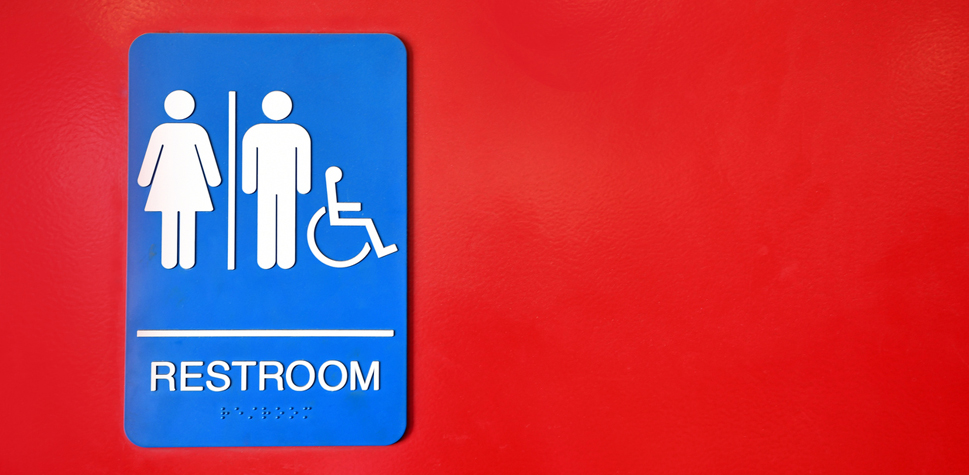Discovering the Trick Attributes of ADA Indications for Enhanced Ease Of Access
In the realm of availability, ADA signs offer as quiet yet effective allies, guaranteeing that rooms are navigable and comprehensive for individuals with handicaps. By integrating Braille and responsive components, these indicators damage obstacles for the visually impaired, while high-contrast shade plans and clear typefaces cater to diverse aesthetic demands.
Value of ADA Conformity
Guaranteeing conformity with the Americans with Disabilities Act (ADA) is important for fostering inclusivity and equivalent access in public areas and offices. The ADA, established in 1990, mandates that all public centers, employers, and transportation solutions suit individuals with impairments, guaranteeing they delight in the exact same civil liberties and opportunities as others. Compliance with ADA criteria not just meets legal obligations however likewise boosts a company's reputation by demonstrating its commitment to diversity and inclusivity.
One of the crucial facets of ADA conformity is the execution of available signage. ADA indications are created to make certain that people with disabilities can quickly navigate with buildings and areas. These indications have to stick to particular guidelines relating to dimension, font style, shade comparison, and placement to guarantee exposure and readability for all. Appropriately implemented ADA signs aids remove obstacles that individuals with specials needs commonly come across, consequently promoting their self-reliance and confidence (ADA Signs).
In addition, sticking to ADA laws can reduce the threat of potential penalties and legal consequences. Organizations that stop working to conform with ADA guidelines might face legal actions or charges, which can be both destructive and economically challenging to their public picture. Hence, ADA compliance is integral to cultivating an equitable atmosphere for everyone.
Braille and Tactile Aspects
The unification of Braille and tactile aspects right into ADA signs symbolizes the concepts of ease of access and inclusivity. It is commonly placed underneath the corresponding text on signage to make sure that individuals can access the info without aesthetic aid.
Tactile aspects prolong beyond Braille and include raised personalities and symbols. These elements are created to be discernible by touch, allowing individuals to identify area numbers, toilets, leaves, and various other crucial locations. The ADA sets certain guidelines pertaining to the size, spacing, and positioning of these tactile components to maximize readability and make sure uniformity across different settings.

High-Contrast Shade Schemes
High-contrast shade schemes play an essential function in boosting the presence and readability of ADA signage for individuals with visual disabilities. These look these up systems are crucial as they make the most of the difference in light reflectance in between message click here to find out more and history, making certain that indicators are easily noticeable, also from a range. The Americans with Disabilities Act (ADA) mandates the usage of particular color contrasts to suit those with limited vision, making it a critical aspect of conformity.
The efficiency of high-contrast shades lies in their capacity to attract attention in numerous lights conditions, including poorly lit atmospheres and areas with glow. Commonly, dark text on a light history or light message on a dark history is utilized to achieve optimal comparison. Black text on a white or yellow background provides a plain aesthetic distinction that helps in fast acknowledgment and comprehension.

Legible Fonts and Text Dimension
When thinking about the style of ADA signage, the choice of understandable font styles and ideal message size can not be overemphasized. The Americans with Disabilities Act (ADA) mandates that font styles need to be sans-serif and not italic, oblique, script, highly decorative, or of uncommon kind.
According to ADA standards, the minimum text elevation ought to be 5/8 inch, and it ought to enhance proportionally with seeing range. Consistency in message dimension contributes to a cohesive visual experience, helping people in browsing atmospheres efficiently.
Moreover, spacing between letters and lines is integral to legibility. Sufficient spacing protects against characters from appearing crowded, enhancing readability. By sticking to these standards, developers click this site can dramatically improve ease of access, ensuring that signs offers its designated function for all individuals, despite their aesthetic capacities.
Reliable Placement Techniques
Strategic positioning of ADA signage is essential for making best use of access and ensuring conformity with lawful criteria. Effectively positioned indications direct people with specials needs effectively, promoting navigation in public areas. Key factors to consider consist of elevation, exposure, and distance. ADA guidelines specify that indicators need to be placed at an elevation between 48 to 60 inches from the ground to guarantee they are within the line of sight for both standing and seated people. This typical height array is essential for inclusivity, making it possible for mobility device users and individuals of differing elevations to access details easily.
Additionally, signs have to be put adjacent to the latch side of doors to allow easy recognition prior to entrance. Consistency in indication positioning throughout a center improves predictability, reducing confusion and enhancing general customer experience.

Verdict
ADA indicators play an essential role in advertising ease of access by incorporating attributes that address the requirements of individuals with disabilities. These aspects jointly cultivate an inclusive setting, highlighting the value of ADA conformity in making sure equal access for all.
In the world of access, ADA indicators serve as quiet yet powerful allies, guaranteeing that areas are accessible and inclusive for individuals with impairments. The ADA, established in 1990, mandates that all public centers, employers, and transport solutions suit individuals with disabilities, ensuring they take pleasure in the exact same legal rights and opportunities as others. ADA Signs. ADA indicators are developed to ensure that individuals with impairments can quickly navigate through structures and spaces. ADA guidelines state that indications must be installed at a height in between 48 to 60 inches from the ground to guarantee they are within the line of view for both standing and seated individuals.ADA signs play an important function in promoting accessibility by incorporating functions that resolve the demands of people with handicaps